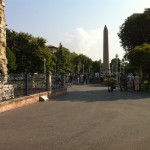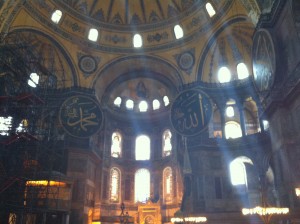
Our day began at the Hippodrome, or what used to be the Hippodrome. After Constantine the Great’s renovation in the 4th century, the Hippodrome could hold as many as 100,000 horse race enthusiasts. It was Churchill Downs on steroids.
Today, as you can see from my picture, there is little left of the Hippodrome, except for two monuments, one a 10th century column dedicated to Emperor Constantine (VII) Porphyrogenitus and the other an Egyptian obelisk on a marble base honoring Emperor Theodosius, which was erected in 390 A.D. (Theodosius, you may or man not know, put an end to what was left of paganism in the empire).
The Turks did to the Hippodrome what Theodosius did to paganism. The Hippodrome began disappearing stone-by-stone after Constantinople fell to the Turks.

Later in the morning, we arrived at Hagia Sophia. Hagia Sophia was completed by Justinian in 537 A.D. and for 800 years was the most beautiful and famous church in the world. When Hagia Sophia was completed, Justinian proclaimed, “Solomon, I have surpassed thee!”
After sacking Constantinople, the Turks converted Hagia Sophia into a mosque, which explains the round billboards in my picture extolling, in Arabic, the virtues of Allah and Muhammad. I’m guessing Justinian never imagined his church would become a mosque. In fact, I’m confident he didn’t since, in 537 A.D., Islam didn’t exist.
Hagia Sophia was not the only church converted to a mosque in Constantinople by the Turks. Hagia Eirene and the church of SS Sergius and Bacchus met the same fate. In fact, nearly every church in Constantinople was converted to a mosque. The once great city, God’s earthly crown jewel, became a Muslim city.
As a Christian, it’s natural to contemplate these events and ask God, “Why?” As a kingdom-believing Christian, convinced the kingdom of God is destined to grow and transform the earth, the loss of Constantinople cannot help but appear to be a major setback.
However, when considering the fleeting nature of buildings, cities and civilizations, even those dedicated to God, it’s important to remember that while the kingdom of God is destined the transform the earth, it also transcends it. God did not choose to place His Holy Spirit in churches–not even the most beautiful one in the world–but in believers. While King Jesus purposes to transform cities and cultures, neither He nor his Kingdom is defined by them. Civilizations come and go, but the kingdom of God endures (Daniel 2:42) and continues to expand. GS

